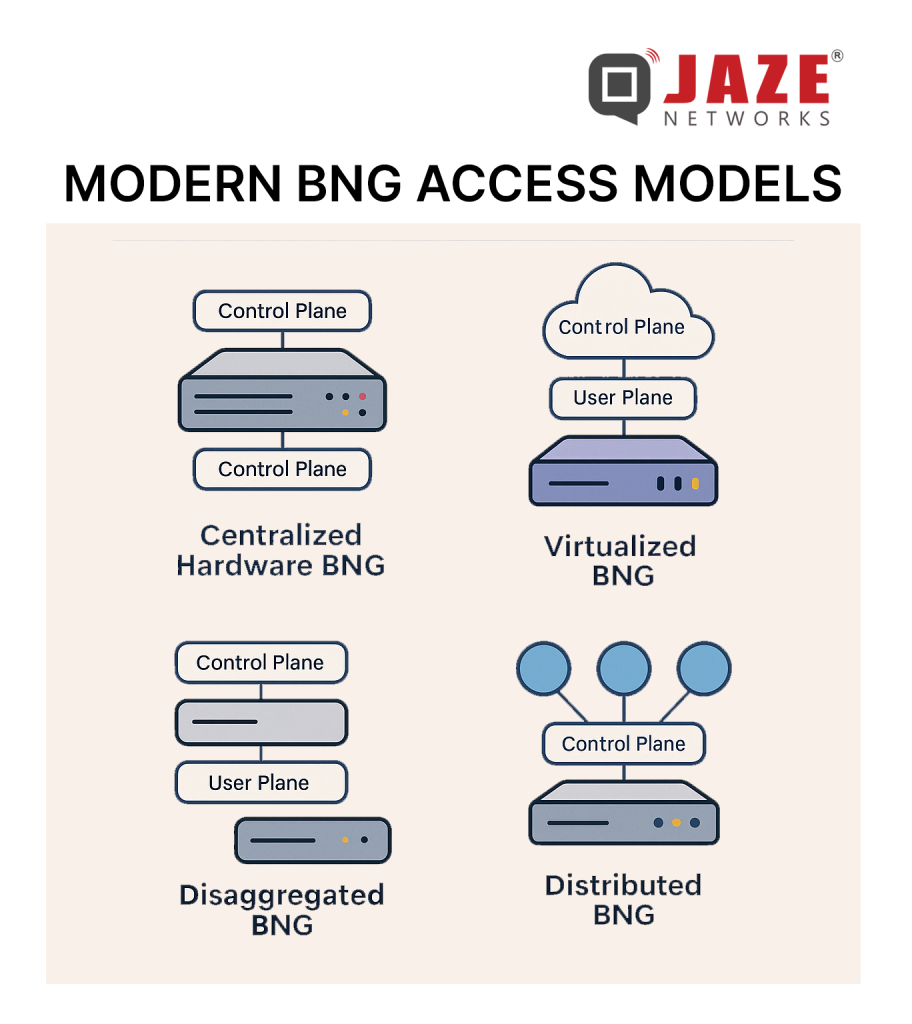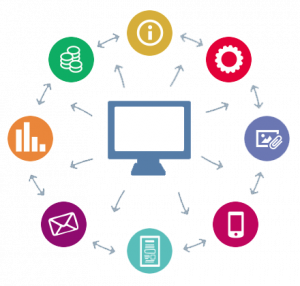The broadband era has surged ahead. With streaming, IoT, remote work and fixed-wireless access all increasing, the role of the Broadband Network Gateway (BNG) is more critical than ever. What used to be a fairly straightforward gateway for customer broadband access is now the core pivot in ISP networks — managing subscriber sessions, enforcing policy, enabling new services.
As ISPs and software providers look ahead, it’s timely to review how BNG access models are evolving — what the new models are, why they matter, and what to consider when redefining your architecture.

Why traditional BNG models are under pressure
Older BNG architectures were largely built around these characteristics:
- Monolithic hardware appliances that terminated subscriber sessions (PPPoE, IPoE) and aggregated access traffic.
- Tight coupling between control plane (subscriber sessions, authentication, policy) and user plane (traffic forwarding).
- Locally deployed at network edge or aggregation sites, fine for earlier broadband traffic patterns.
However, several shifts are making this traditional model less effective:
- Explosion in subscriber counts and traffic volumes (streaming, remote work, multi-device households).
- Rise of fixed-wireless access, WiFi 6/7, mobile-fixed convergence — more access models, more diversity.
- Need for faster service deployment, agility, cloud and virtualization to reduce CAPEX/OPEX.
- Edge computing and distributed services demand lower latency, flexible forwarding plane closer to the user.
Because of this, ISPs must rethink the BNG — the access model, deployment location, and software vs hardware trade-offs.
Key Access Models for Modern BNGs
Here are several access models emerging in the BNG space — useful to understand for product positioning, network architecture or software service strategy:
1. Centralised hardware BNG
- The classic model: a fixed appliance at aggregation/edge handles control & user plane.
- Pros: mature, predictable, known performance.
- Cons: less flexible, harder to scale dynamically, slower to introduce new services or access types.
2. Virtualised / Cloud-Native BNG (vBNG)
- BNG functions (control & possibly user plane) are virtualised on commodity hardware or cloud infrastructure.
- Enables: pay-as-you-grow, faster service rollout, easier software updates and orchestration.
- For ISPs, this means software platforms (subscription management, policy control, automation) become critical pillars.
3. Disaggregated BNG with Control/User Plane Separation (CUPS)
- Here the control plane (session management, subscriber state) and user plane (traffic forwarding) are separated, potentially located in different parts of the network.
- Benefits: user plane can be placed closer to the edge (reducing latency/backhaul), control plane remains centralised/virtualised for scale.
- Supports multi-access (fixed + wireless) and converged services — critical for modern ISPs.
4. Edge/Distributed BNG for Multi-Access & Hybrid Networks
- As broadband access diversifies (fiber, FWA, WiFi, hybrid fixed/mobile), ISPs need BNG models that can adapt:
- Multiple access types handled under a common policy/control system.
- User plane distributed to edge nodes or aggregation sites for performance.
- Multiple access types handled under a common policy/control system.
- This mode underscores the software-defined and distributed architecture trend.

Why these models matter to ISPs and SaaS providers
From the vantage of an ISP or a software vendor for ISPs, understanding these access models gives you strategic insight:

Cost efficiency & scalability: Virtualised/disaggregated BNGs reduce hardware dependency, enable scaling with demand, lower OPEX.
Service agility: Faster introduction of new pricing tiers, service bundles, new access types (FWA, WiFi) — software control matters.
Operational simplicity: Central control plane means fewer edge-appliances to manage; disaggregation means upgrades, scaling becomes less disruptive.
Edge performance & user experience: With distributed user plane, latency and backhaul loads are reduced, supporting high-quality real-time services.
Convergence & future-proofing: Fixed + wireless + multi-access handled by common architecture means ISPs are better positioned for 5G, IoT, edge-services.
What to evaluate when selecting your BNG access model
Here’s a quick checklist for ISPs and software vendors to assess their BNG strategy:
Subscriber scale & growth: Can the model scale out linearly with subscriber growth and traffic loads?
Access diversity: Will your access types (fiber, FWA, WiFi) be supported under the model?
Control vs user plane location: How decoupled are they? Where will user plane be located for optimal performance?
Software orchestration & automation: Are provisioning, policy, subscriber lifecycle fully automated?
Service agility: How quickly can new tariff plans, bundles, access services be introduced?
Hardware dependency: What is the capex/opex trade-off? Can you move toward software-defined alternatives?
Edge readiness & latency: If you support real-time or OTT services, is your user plane close enough to the edge?
Vendor ecosystem & integration: Does the solution support open interfaces, multi-vendor, easier upgrades?
Whether you go for a centralised appliance, a virtualised cloud-native gateway, a disaggregated CUPS architecture or an edge-distributed model — the common theme is flexibility, software-first, multi-access readiness and subscriber-centric policy control. For ISPs and the SaaS companies that serve them, aligning your strategy (and your software platform) with these modern BNG access models means you’re not just keeping up — you’re positioning for next-gen broadband services, better user experience and operational advantage.
Jaze ISP Manager offers seamless integration with leading BNG/BRAS platforms — enabling ISPs to manage subscriber sessions, enforce policy across all access types, automate provisioning and billing, and monitor network health from one unified dashboard. Whether you are operating a traditional hardware BNG, moving to virtualised models or adopting a distributed edge architecture, Jaze ISP Manager supports the full lifecycle: from onboarding to churn, with scalability built in.
Click here to learn more.






